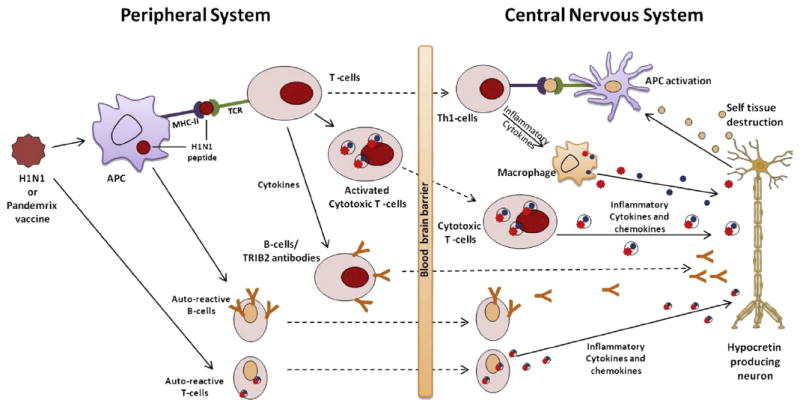Fig. 1.

Possible pathway for a role of H1N1 seasonal infection and Pandemrix vaccination in onset of narcolepsy: the seasonal H1N1 influenza infection or the Pandemrix vaccine could stimulate auto-reactive T-cells or B-cells targeting towards hypocretin producing neurons via several different mechanisms. (i) Molecular mimicry of T-cells, it describes the activation of cross-reactive T-cells that recognize the H1N1 epitope and then the same T-cell (or a clone) migrates to the CNS, where it recognizes a antigen specific to hypocretin producing neurons (cross-reactivity). Activation of cross-reactive T cells results in release of cytokines and chemokines that recruits and activates macrophages, which mediates self-tissue damage. The subsequent release of hypocretin self antigen and their uptake by APCs perpetuate the autoimmune disease narcolepsy. (ii) H1N1 antigens or Pandemrix vaccine may cross-link the MHC and TCR molecules independent of antigen specificity and activates the cytotoxic T cells which are auto reactive and specific towards hypocretin producing neurons. (iii) Molecular mimicry involving B-cells and antibody mediated disease could also be involved, possibly targeting TRIB2 as a cross-reactive antigen. This process requires signals from activated T-cells (T-cell help). Bystander activation of resting auto-reactive B cells (iv) and T cells (v) as a result of general immune activation independent of specific antigens. Current results in narcolepsy research point towards a T-cell mechanism. APC: Antigen presenting cell; CNS: Central nervous system; H1N1: H1N1 influenza A virus or epitopes from adjuvant vaccines; MHC: Major histocompatibility complex; TCR: T-cell receptor; TRIB2: tribbles homologue 2.
